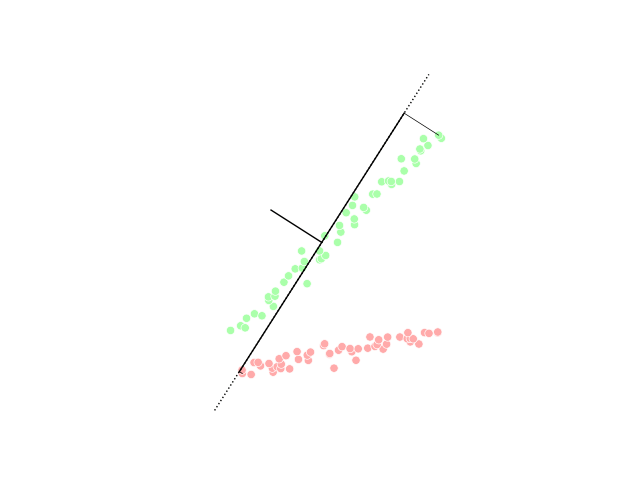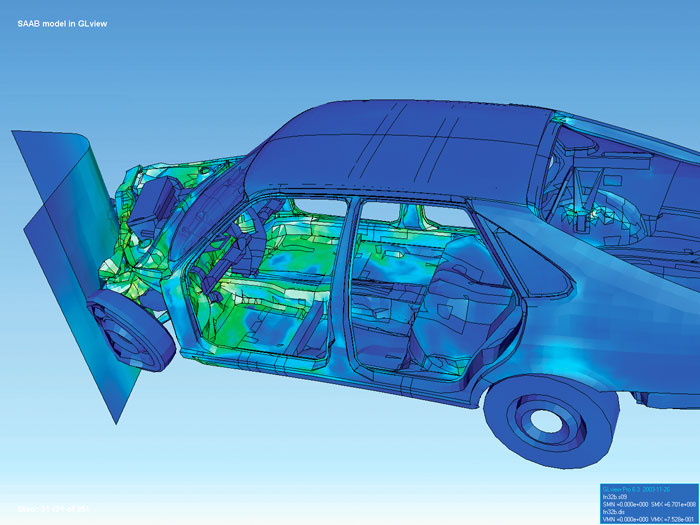|
Guyan Reduction
In computational mechanics, Guyan reduction, also known as static condensation, is a dimensionality reduction method which reduces the number of degrees of freedom by ignoring the inertial terms of the equilibrium equations and expressing the unloaded degrees of freedom in terms of the loaded degrees of freedom. Basic concept The static equilibrium equation can be expressed as: : \mathbf\mathbf = \mathbf where \mathbf is the stiffness matrix, \mathbf the force vector, and \mathbf the displacement vector. The number of the degrees of freedom of the static equilibrium problem is the length of the displacement vector. By partitioning the above system of linear equations with regards to loaded (master) and unloaded (slave) degrees of freedom, the static equilibrium equation may be expressed as: : \begin \mathbf_ & \mathbf_ \\ \mathbf_ & \mathbf_ \end \begin \mathbf_ \\ \mathbf_ \end = \begin \mathbf_ \\ \mathbf_ \end Focusing on the lower partition of the above system of linear eq ... [...More Info...] [...Related Items...] OR: [Wikipedia] [Google] [Baidu] |
Computational Mechanics
Computational mechanics is the discipline concerned with the use of computational methods to study phenomena governed by the principles of mechanics. Before the emergence of computational science (also called scientific computing) as a "third way" besides theoretical and experimental sciences, computational mechanics was widely considered to be a sub-discipline of applied mechanics. It is now considered to be a sub-discipline within computational science. Overview Computational mechanics (CM) is interdisciplinary. Its three pillars are mechanics, mathematics, and computer science. Mechanics Computational fluid dynamics, computational thermodynamics, computational electromagnetics, computational solid mechanics are some of the many specializations within CM. Mathematics The areas of mathematics most related to computational mechanics are partial differential equations, linear algebra and numerical analysis. The most popular numerical methods used are the finite element, fini ... [...More Info...] [...Related Items...] OR: [Wikipedia] [Google] [Baidu] |
Dimensionality Reduction
Dimensionality reduction, or dimension reduction, is the transformation of data from a high-dimensional space into a low-dimensional space so that the low-dimensional representation retains some meaningful properties of the original data, ideally close to its intrinsic dimension. Working in high-dimensional spaces can be undesirable for many reasons; raw data are often sparse as a consequence of the curse of dimensionality, and analyzing the data is usually computationally intractable. Dimensionality reduction is common in fields that deal with large numbers of observations and/or large numbers of variables, such as signal processing, speech recognition, neuroinformatics, and bioinformatics. Methods are commonly divided into linear and nonlinear approaches. Linear approaches can be further divided into feature selection and feature extraction. Dimensionality reduction can be used for noise reduction, data visualization, cluster analysis, or as an intermediate step to facilitat ... [...More Info...] [...Related Items...] OR: [Wikipedia] [Google] [Baidu] |
Change Of Basis
In mathematics, an ordered basis of a vector space of finite dimension allows representing uniquely any element of the vector space by a coordinate vector, which is a sequence of scalars called coordinates. If two different bases are considered, the coordinate vector that represents a vector on one basis is, in general, different from the coordinate vector that represents on the other basis. A change of basis consists of converting every assertion expressed in terms of coordinates relative to one basis into an assertion expressed in terms of coordinates relative to the other basis. Such a conversion results from the ''change-of-basis formula'' which expresses the coordinates relative to one basis in terms of coordinates relative to the other basis. Using matrices, this formula can be written :\mathbf x_\mathrm = A \,\mathbf x_\mathrm, where "old" and "new" refer respectively to the initially defined basis and the other basis, \mathbf x_\mathrm and \mathbf x_\mathrm are the ... [...More Info...] [...Related Items...] OR: [Wikipedia] [Google] [Baidu] |
Transformation Matrix
In linear algebra, linear transformations can be represented by matrices. If T is a linear transformation mapping \mathbb^n to \mathbb^m and \mathbf x is a column vector with n entries, then there exists an m \times n matrix A, called the transformation matrix of T, such that: T( \mathbf x ) = A \mathbf x Note that A has m rows and n columns, whereas the transformation T is from \mathbb^n to \mathbb^m. There are alternative expressions of transformation matrices involving row vectors that are preferred by some authors. Uses Matrices allow arbitrary linear transformations to be displayed in a consistent format, suitable for computation. This also allows transformations to be composed easily (by multiplying their matrices). Linear transformations are not the only ones that can be represented by matrices. Some transformations that are non-linear on an n-dimensional Euclidean space R''n'' can be represented as linear transformations on the ''n''+1-dimensional space R''n''+1. T ... [...More Info...] [...Related Items...] OR: [Wikipedia] [Google] [Baidu] |
Dynamic Substructuring
Dynamic substructuring (DS) is an engineering tool used to Physical model, model and Analysis, analyse the Dynamics (mechanics), dynamics of mechanical systems by means of its components or substructures. Using the dynamic substructuring approach one is able to analyse the dynamic behaviour of substructures separately and to later on calculate the assembled dynamics using coupling procedures. Dynamic substructuring has several advantages over the analysis of the fully assembled system: * Substructures can be modelled in the domain that is most appropriate, e.g. experimentally obtained substructures can be combined with Finite element method in structural mechanics, numerical models. * Large and/or complex systems can be optimized on substructure level. * Numerical computation load can be reduced as solving several substructures is computationally less demanding than solving one large system. * Substructure models of different development groups can be shared and combined without expo ... [...More Info...] [...Related Items...] OR: [Wikipedia] [Google] [Baidu] |
Model Order Reduction
Model order reduction (MOR) is a technique for reducing the computational complexity of mathematical models in numerical simulations. As such it is closely related to the concept of metamodeling, with applications in all areas of mathematical modelling. Overview Many modern mathematical models of real-life processes pose challenges when used in numerical simulations, due to complexity and large size (dimension). Model order reduction aims to lower the computational complexity of such problems, for example, in simulations of large-scale dynamical systems and control systems. By a reduction of the model's associated state space dimension or degrees of freedom, an approximation to the original model is computed which is commonly referred to as a reduced order model. Reduced order models are useful in settings where it is often unfeasible to perform numerical simulations using the complete full order model. This can be due to limitations in computational resources or the requir ... [...More Info...] [...Related Items...] OR: [Wikipedia] [Google] [Baidu] |
Finite Element Method
Finite element method (FEM) is a popular method for numerically solving differential equations arising in engineering and mathematical modeling. Typical problem areas of interest include the traditional fields of structural analysis, heat transfer, fluid flow, mass transport, and electromagnetic potential. Computers are usually used to perform the calculations required. With high-speed supercomputers, better solutions can be achieved and are often required to solve the largest and most complex problems. FEM is a general numerical method for solving partial differential equations in two- or three-space variables (i.e., some boundary value problems). There are also studies about using FEM to solve high-dimensional problems. To solve a problem, FEM subdivides a large system into smaller, simpler parts called finite elements. This is achieved by a particular space discretization in the space dimensions, which is implemented by the construction of a mesh of the object: the numer ... [...More Info...] [...Related Items...] OR: [Wikipedia] [Google] [Baidu] |
Schur Complement
The Schur complement is a key tool in the fields of linear algebra, the theory of matrices, numerical analysis, and statistics. It is defined for a block matrix. Suppose ''p'', ''q'' are nonnegative integers such that ''p + q > 0'', and suppose ''A'', ''B'', ''C'', ''D'' are respectively ''p'' × ''p'', ''p'' × ''q'', ''q'' × ''p'', and ''q'' × ''q'' matrices of complex numbers. Let M = \begin A & B \\ C & D \end so that ''M'' is a (''p'' + ''q'') × (''p'' + ''q'') matrix. If ''D'' is invertible, then the Schur complement of the block ''D'' of the matrix ''M'' is the ''p'' × ''p'' matrix defined by M/D := A - BD^C. If ''A'' is invertible, the Schur complement of the block ''A'' of the matrix ''M'' is the ''q'' × ''q'' matrix defined by M/A := D - CA^B. In the case that ''A'' or ''D'' is singular, substituting a generalized inverse for the inverses on ''M/A'' and ''M/D'' yields the generalized Schur complement. The Schur complement is named after Issai Schur who used it to ... [...More Info...] [...Related Items...] OR: [Wikipedia] [Google] [Baidu] |

